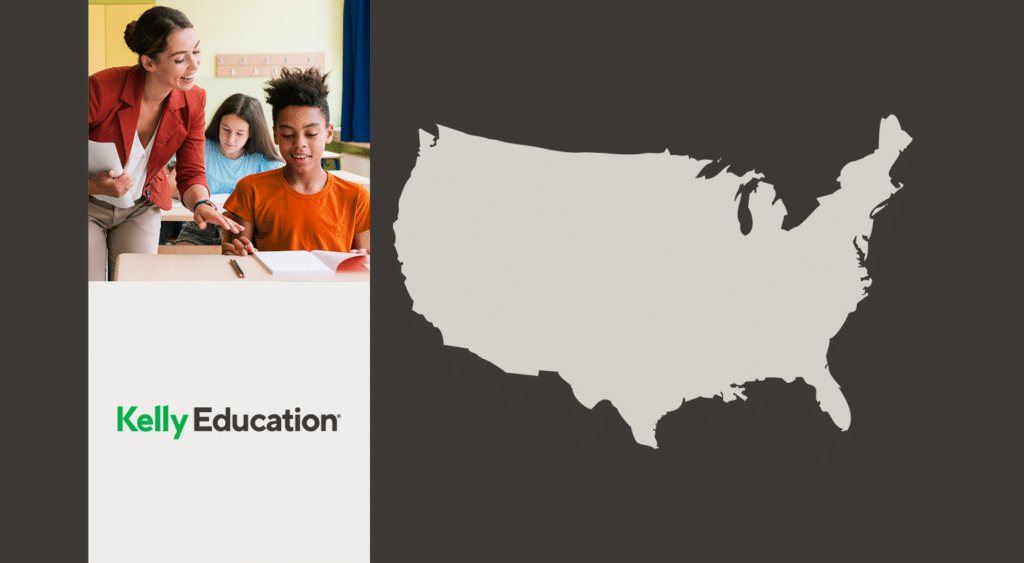How to become a paraprofessional in Minnesota.

To become a paraprofessional in Minnesota, there are several ways to meet the state’s minimum requirements including: an associate degree, 60 college credits from an accredited institution, or passing a test.
Let’s look more closely at what it takes to land this important role in schools that makes a difference in students’ lives.
Minimum paraprofessional requirements in Minnesota, at a glance:
Must meet one of the following criteria:
- Two years of college coursework from accredited institution
- Associate degree or higher
- Passing score of a qualifying assessment, such as the ParaPro
- Meet the competencies listed in the MDE approved competency grid
In addition to Minnesota state requirements, Kelly Education requires:
- Pre-hire training
- New hire orientation
In this role, you’ll provide essential support to students with special needs who have Individual Education Plans (IEPs)
At Kelly Education, we use the job title “paraeducator” to highlight the professionalism of this role—just as paralegals or paramedics. School districts may also use titles including education assistant, paraprofessional, instructional aide, or instructional support staff.
A deeper dive into paraeducator requirements.
Kelly Education works with schools across Minnesota to place paraeducators, so we know what it takes to get started. While the state doesn’t have a long list of requirements, the process can still take a little time, usually a few days to a few weeks.
How quickly things move depends on how soon you complete each step. Background checks and fingerprinting, in particular, can slow things down, so it’s helpful to get those going early.
Education requirements and verification.
The Minnesota Department of Education requires that paraprofessionals have either completed at least two years (60 credits) of college coursework or have an associate degree or higher to become paraprofessionals. College coursework must be completed through an accredited institution.
As an alternate to higher education, you can also become a paraeducator in Minnesota if you pass an approved formal academic assessment or meet the competencies listed in the MDE approved competency grid.
You’ll need to contact your high school, college, or university records departments to provide your transcripts. There may be a small fee to have them transferred. If you work with Kelly Education, we’ll guide you through this step.
Experience.
While there are no specific experience requirements, you may be more likely to gain a position as a paraprofessional if you have experience working with children, have excellent communication skills, and function well as a member of a team.
Background screening and fingerprinting.
All states require some level of background check and fingerprinting for individuals working directly with children and in school districts. Individual school districts may have their own rules beyond the basics, which could also include drug screening or additional background checks. Applicants are typically responsible for the cost of these background checks, and results may take up to two weeks to process.
Also, when you work for Kelly Education, all paraeducator candidates are checked against the National Sex Offender Registry.
Training and voluntary credential.
Per the Individuals with Disabilities Education Act (IDEA), a federal law, paraprofessionals must receive appropriate training if they work with students who have special needs. In Minnesota, the school district must provide training for paraprofessionals during the first 60 days of employment.
We also recommend that substitute paraprofessionals pursue CPR and First Aid certification. Although these are optional for the paraprofessional role, these emergency response competencies are important for student safety. Some employers may provide First Aid training for free, but you can find courses locally for these certifications for about $50.
While not required, individuals in the state of Minnesota can also choose to get an additional accreditation through the Minnesota Professional Educator Licensing and Standards Board (PELSB). This accreditation is voluntary but can help you stand out from other applicants when applying to various paraprofessional roles.
When you work through Kelly Education, we’ll also make sure you’re set up for success. All applicants must complete a pre-hire module called ParaSmarts, which outlines role-specific duties and best practices. Once hired, you’ll receive an online one-hour New Hire Orientation. It summarizes Kelly Education policies and the specific school district’s regulations
Employment verification.
Anyone who works in schools must prove eligibility to work in the United States. To complete this step, you’ll submit an I-9 form with valid identification credentials.
If you work with Kelly Education, our team will help you with this. If working for a district, you’ll typically work on this with the human resources team.
Become a substitute paraeducator with Kelly Education.
If you or someone you know is interested in paraprofessional or substitute teaching jobs, fill out our brief interest form, and one of our recruiters will contact you to answer your questions.
To learn more, explore our helpful library of articles for paraprofessionals and school educators.
- What is a paraprofessional in schools
- Understanding IEP and 504 plans
- Paraeducator job description, duties, and responsibilities
*Information subject to change. This is a general guideline as of July 2025. School districts may have additional requirements in addition to state requirements.
View Related: Applying for jobs Article Job searching
You might like
Find your next job
Discover thousands of temporary, full-time, and remote jobs for beginning and experienced job seekers.



